The document discusses one-dimensional arrays in C++. It defines an array as a series of elements of the same type that can be referenced collectively by a common name. These elements are placed in consecutive memory locations and can be individually referenced using a subscript or index. The document covers declaring and initializing one-dimensional arrays, accessing array elements individually and collectively, inputting and displaying array elements, and provides examples of programs that work with arrays.
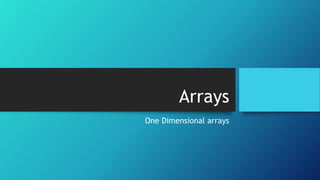
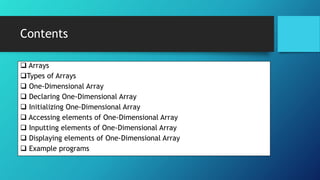
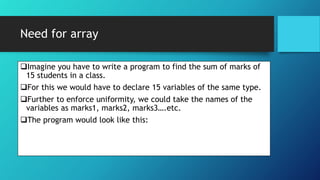

![What is an array?
An array is a series of elements (variables) of the same type which
can be referenced collectively by a common name.
These elements are placed in consecutive memory locations .
They can be individually referenced by adding an index or
subscript to the unique name.
In the above scenario, to store marks of the 6 students, we could
declare an array:
int marks[6];](https://image.slidesharecdn.com/arrays-171006175150/85/Arrays-5-320.jpg)
![Declaration of marks array and memory
representation
int marks[6]; Memory Representation
array name subscript or index value
array element
Name of the array
Number of elements
Data type of
the array
marks[5]
marks[3]
marks[2]
marks[1]
marks[0]
marks[4]](https://image.slidesharecdn.com/arrays-171006175150/85/Arrays-6-320.jpg)
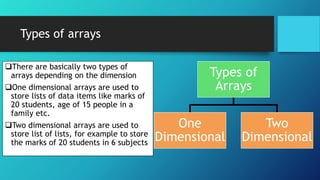
![Declaring a one-dimensional array
Syntax :
type name[integer constant/literal];
• type is the data type of the array. It can be int, float or char or
user defined(discussed in later chapters)
• name is any valid c++ identifier
• the number of elements in the array has to be an integer
constant or literal.
• The size of the array in bytes= data type size X no of elements
The elements of an array are the individual variables which can be
referenced by a subscript value](https://image.slidesharecdn.com/arrays-171006175150/85/Arrays-8-320.jpg)
![One dimensional array declarations
int runs[6];
Size of array=2X6=12 bytes
(size of int X no of elements)
Data type of
each element
Name of
the array
const int x=8;
int scores[x];
Here x is a named
constant with value 8.
Thus number of
elements in the above
array=8
float salary[20];
Size of array=4X20=80 bytes
(size of floatX no of elements)
Data type of
each element
No of elementsNo of elements
No of
elements](https://image.slidesharecdn.com/arrays-171006175150/85/Arrays-9-320.jpg)
![One dimensional arrays examples
One dimensional arrays are simple lists. They may be lists of
numbers, marks or characters depending on the data type of the
array. Examples:
int age[20]; //represents the age of 20 people
float salary[15];// represents the salary of 15 employees
char alphabets[24];// represents the alphabets](https://image.slidesharecdn.com/arrays-171006175150/85/Arrays-10-320.jpg)
![Memory representation of an array
Consider the following array declaration:
int a[4]; memory representation
Data type =integer
Name=a
Number of elements=4
Size = 4 X 2=8 bytes array elements
Here a is an array having 4 elements , each of type int. Each of the element can
be referred individually using name of the array and subscript value eg, a[0],
a[1] etc.
a[0] a[2] a[3]a[1]
Note: the array subscript always starts from 0. The numbering of subscript of an
array with n elements varies from 0 to n-1. Thus an array of 4 elements will be
having subscripts from 0 to 3](https://image.slidesharecdn.com/arrays-171006175150/85/Arrays-11-320.jpg)
![Initializing an array
To initialize a one dimensional array we need to specify data values enclosed in
curly braces. These data values are called initializers.
Data-type name[size]={initialvalue1,initialvalue2, initialvalue3,initialvalue4…..};
The data type of the initializers should match with the data type of the array
and number of initializers should match with the size of the array.
If the number of initializers are more than the size of the array, an error is
generated.](https://image.slidesharecdn.com/arrays-171006175150/85/Arrays-12-320.jpg)
![Initializing an array
• Example :
int marks[6]={15, 24, 20, 18, 22, 25};
15 24 20 18 22 25](https://image.slidesharecdn.com/arrays-171006175150/85/Arrays-13-320.jpg)
![More examples of array initializations
• int age[4]={25, 34, 60, 22};
0 1 2 3
• float salary[8]={45.5, 34,5, 45.0, 87.0,56.5, 78.0, 90.0, 54.5, 67.0};
0 1 2 3 4 5 6 7
25 34 60 22
45.5 34.5 45.0 87.0 56.5 78.0 54.5 67.0](https://image.slidesharecdn.com/arrays-171006175150/85/Arrays-14-320.jpg)
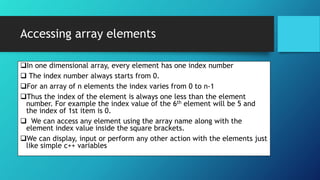
![Accessing array elements
The elements of an array can be accessed individually as well as
collectively.
To access individual array elements the syntax is :
name[subscript]
• Example :
For the array marks :
cout<< marks[1]; // displays 24
cout<<marks[4]; // displays 22
15
24
20
18
22
25
marks[0]
marks[1]
marks[2]
marks[3]
marks[4]
marks[5]](https://image.slidesharecdn.com/arrays-171006175150/85/Arrays-16-320.jpg)
![Accessing array elements individually
Consider an array : int num[4];
Let us assign some values to the
elements individually:
• Example :
num[0]=9;
num[2]=6;
9
6
0
1
2
3
Let us now do some more calculations
with elements of the same array :
• Example :
num[0]=num[0]+2 ;
(num[0]=9, num[0]+2=11)
num[3]=num[2]+num[0];
(num[2]=6, num[0]=11)
11
6
17](https://image.slidesharecdn.com/arrays-171006175150/85/Arrays-17-320.jpg)
![Some more examples of accessing array
elements
Example Statement Meaning
age[3]=22; Assign the value 22 to the 2nd element of the array age
runs[4]=20*2; Assign the product of 20 and 2 to the 5th element of the array
runs
cin>>list[5] ; Input the 6th element of the array list
scores[7]=scores[4]+90; Add 90 to the 5th element of array score and assign the result to
the 8th element of the array
cout<<age[8 ]; Display the content of the 9th element of array age.
average=(scores[0]+scores[1])/2; find the average of score 1 and 2 and assign it to the variable
average.
age[i-2]= s+t; Assign the sum of s and t to the element of array whose index is
given by the expression i-2](https://image.slidesharecdn.com/arrays-171006175150/85/Arrays-18-320.jpg)
![Accessing array elements collectively
To assign values collectively we use a loop
Let us assign some values to the elements of the same array
collectively:
• Example : num[0]:= i=0, i*2=0
for(int i=0;i<4; i++) num[1]:= i=1, i*2=2
num[i]=i*2; num[2]:= i=2, i*2=4
num[3]:= i=3, i*2=6
Thus using a loop we can access all the elements of the array one
by one(or sequentially). The value of the index varies from 0 to 3
thus assigning the values to the elements accordingly.
0
2
4
6](https://image.slidesharecdn.com/arrays-171006175150/85/Arrays-19-320.jpg)
![Input into an array
To input values into an array we can use the for loop. Each element is accessed
individually.
int nums[4];
for(int i=0; i<4; i++)
cin>>nums[i];
The value of i will vary from 0 to 3, thus in the first pass, value of i=0.
cin>>nums[i]= cin>>nums[0]
In the second pass, value of i=1, thus
cin>>nums[i]= cin>>nums[1] and so on.](https://image.slidesharecdn.com/arrays-171006175150/85/Arrays-20-320.jpg)
![Displaying contents of an array
To diplay values of an array we can use the for loop again to access each
element individually.
for( i=0; i<4; i++)
cout<<nums[i];
The value of i will vary from 0 to 3, thus in the first pass, value of i=0.
cout<<nums[i]= cout<<nums[0]
In the second pass, value of i=1, thus
cout<<nums[i]= cout<<nums[1]
and so on.](https://image.slidesharecdn.com/arrays-171006175150/85/Arrays-21-320.jpg)
![Program to input values into an array and
display array contents
#include<iostream.h>
void main()
{
int nums[4];
cout<<“Enter the list of numbers :”;
for(int i=0; i<4; i++)
cin>>nums[i];
cout<<“n The numbers you entered are :”;
for (i=0;i<4;i++)
cout<<nums[i]<<“n”;
}
Enter the list of numbers :
2
5
6
8
The numbers you entered are :
2
5
6
8
Output](https://image.slidesharecdn.com/arrays-171006175150/85/Arrays-22-320.jpg)
![Program to input the marks of 6 students and
find the average score
#include<iostream.h>
#include<conio.h>
void main()
{
clrscr();
float marks[6], sum=0;
for(int i=0; i<6; i++) //loop for reading marks
{
cout<< “Enter marks of student “<< i+1<<”:”;
cin>> marks[i];
}
for(int j=0; j<6; j++) //loop for accumulating sum of marks
{
sum=sum+marks[j];
}
cout<<endl<<”Marks you have entered are :”<<endl;
for(j=0; j<6; j++) //loop for displaying the marks
{
cout<< “Marks of student “<< j+1<<”:”;
cout<< a[j]<<endl;
}
cout<<”nTotal marks : “<<sum;
cout<<“nAverage marks :”<<sum/6;
getch();
}
Enter marks of student 1: 24
Enter marks of student 2: 25
Enter marks of student 3: 22
Enter marks of student 4: 20
Enter marks of student 5: 25
Enter marks of student 6: 22
Marks you have enetered are :
Marks of student 1:24
Marks of student 2:25
Marks of student 3:22
Marks of student 4:20
Marks of student 5:25
Marks of student 6:22
Total marks :138
Average marks :23
Output](https://image.slidesharecdn.com/arrays-171006175150/85/Arrays-23-320.jpg)

![Entering unknown number of elements…contd
For this we need to partially
fill the array depending on
the number of students eg 25
or 40 etc. So we take a
variable say n and run the
loop from 0 to n-1.
int marks[50], n;
cout<<“nenter number of students:
“;
cin>>n;
for(int i=0;i<n;i++)
cin>>marks[i];
Here marks[50] is the array and n is
the number of students whose marks
are to be entered. So the loop will run
from 0 to n-1 and input marks of n
students.
Explanation
Example](https://image.slidesharecdn.com/arrays-171006175150/85/Arrays-25-320.jpg)
![#include<iostream.h>
#include<conio.h>
void main()
{
clrscr();
float marks[50], sum=0,n;
cout<<“Enter number of students in class:”;
cin>>n;
for(int i=0; i<n; i++) //loop for reading marks
{
cout<< “Enter marks of student “<< i+1<<”:”;
cin>> marks[i];
}
for(int j=0; j<n; j++) //loop for accumulating sum of marks
{
sum=sum+marks[j];
}
cout<<”nTotal marks : “<<sum;
cout<<“nAverage marks :”<<sum/n;
getch();
}
Program to input the marks of n students and
find the average score
Enter number of students in class
4
Enter marks of student 1: 90
Enter marks of student 2: 80
Enter marks of student 3: 75
Enter marks of student 4: 85
Total marks : 330
Average marks :82.5
Output](https://image.slidesharecdn.com/arrays-171006175150/85/Arrays-26-320.jpg)
![Program to read temperatures for unknown
number of days and find average temperature
#include<iostream.h>
void main()
{
float temp[20]; int n=0;char ch=‘y’;
do
{cout<<“nEnter temperature for day ”<<n+1<<“:”;
cin>>temp[n];
cout<<“nEnter more (y/n)? ”;
cin>>ch;
n++;
}while(ch!=‘n’ || ch!=‘n’);
for(int i=0; i<n;i++)
sum+=temp[i];
cout<<“nAverage temp is :”<<sum/n;
}
Enter temperature for day 1: 25.5
Enter more(y/n)? Y
Enter temperature for day 2: 26.5
Enter more(y/n)? Y
Enter temperature for day 3: 27.0
Enter more(y/n)? Y
Enter temperature for day 4: 24.5
Enter more(y/n)? Y
Enter temperature for day 5: 25.0
Enter more(y/n)? N
Average temp is : 25.7
Output](https://image.slidesharecdn.com/arrays-171006175150/85/Arrays-27-320.jpg)

![Program to find maximum number in an array
#include<iostream.h>
void main()
{
int nums[20];
cout<<Ënter the number of list items:”;
cin>>n;
cout<<“Enter the list of numbers :”;
for(int i=0; i<n; i++)
cin>>nums[i];
int max=nums[0];
for (i=0;i<n;i++)
if(nums[i]>max)
max=nums[i];
cout<<“n The largest number is :”<<max;
}
Enter the number of list items:
6
Enter the list of numbers :
22
11
56
62
80
44
The largest number is : 80
Output](https://image.slidesharecdn.com/arrays-171006175150/85/Arrays-29-320.jpg)